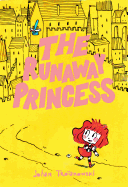
If someone collected the stream-of-consciousness storytelling of the world's most imaginative children, it might read something like The Runaway Princess.
In the first of the graphic novel's three parts, "The Princess Runs Away (and Makes Some Friends)," Princess Robin of Seddenga flees from the castle. Who can blame her for skipping etiquette class when outside the castle walls is the Aquatic Carnival in Noor, the City of Water? On the way, she meets four abandoned brothers in the forest and leads them to safety. In "The Princess Runs Away Again (by Accident This Time)," Robin and the brothers are playing hide-and-seek in the castle gardens when she hears a voice inside a well calling her name. That night, the voice lures her from the castle while she's sleeping. And in "The Princess Tries to Stay in One Place (but the Weather Doesn't Cooperate)," Robin and the brothers are playing pirates when a storm comes. They scuttle to safety aboard a ship, which is swept away to a deserted island.
Johan Troïanowski grounds his impetuous storytelling with allusions to iconic children's tales: redheaded, red-frocked Robin's amble through the forest recalls Little Red Riding Hood's, and the kids encounter a Cheshire cat and a gingerbread house. Yet The Runaway Princess is unmistakably a modern confection, with the book's robot bugs and lines like "Ow! I've bumped my booty." Troïanowski's dainty hand-drawn and -colored illustrations range from modest panels to two-page spreads; some pages feature activities. More interactivity is on offer through the text's dozen or so calls for action, from either a cast member or an omniscient narrator. This improvised, kitchen-sink quality gives The Runaway Princess the look and feel of a sumptuous, thrown-together royal feast. --Nell Beram, freelance writer and YA author

